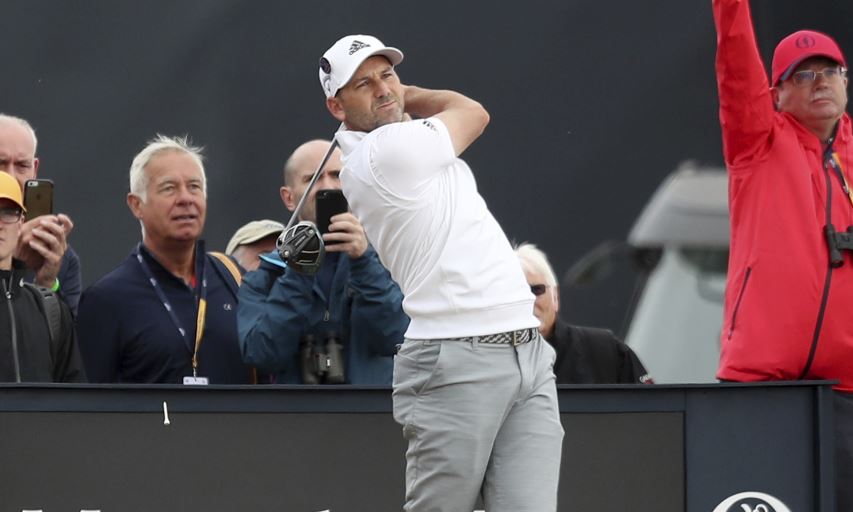Sergio Garcia Plays From The 2nd Tee During A Practice Round Ahead Of The 2018. (AP Photo/Jon Super)
By DOUG FERGUSON, Associated Press
CARNOUSTIE, Scotland — The eve of the British Open felt like cramming for a final exam, a multiple choice one with no obvious answers.
The wind that blows off the North Sea across the exposed links of Carnoustie has not been the primary concern during practice rounds. Players have a reasonable idea how far the ball travels in the air. They just don’t know how far it goes on the ground.
“If you get it downwind and you hit that little flat draw and it gets running, it will go pretty much until it runs into something,” Justin Thomas said.
That’s not entirely true.
Thomas hit a tee shot on the third hole Wednesday afternoon that rolled across the humps in the fairway and kept right on rolling. It looked as though it would run into a bunker, or maybe even the handle of a rake leaning on the left edge of the bunker. It missed both and eventually came to a stop 232 yards away.
His club off the tee was an 8-iron.
Tiger Woods doesn’t see many occasions to hit driver because of how far the ball is rolling across tight links grass that looks dead. It hasn’t been this dry since Hoylake in 2006, when Woods hit only one driver all week and captured the Open for the third time. This might not be much different.
“It’s just hard to keep the ball in play,” he said. “It’s going to be an interesting test to see which clubs we’re going to be using off the tees, and a lot of it is dependent on which way the wind blows. So the whole idea of these practice rounds is just to get a good feel for what I’m going to do, and then adjust accordingly.”
Others are coming to a different conclusion. Because while the links are as fast as ever, the rough is too thin, too wispy to wreak havoc. Dustin Johnson, the No. 1 player in the world, figures he’ll hit driver about half the time on the 15 holes that are not par 3s. Two-time U.S. Open champion Brooks Koepka also is bullish on the big stick, saying the driver will come out on about eight or nine holes.
Defending champion Jordan Spieth was considering his options on the final day of practice. On the 415-yard fourth hole, with a bunker on the right side of a dogleg left and another bunker farther out on the left side, he hit a fade over the right bunker. The other option is a long iron that splits the bunker.
And then Spieth had another idea.
“Aim for the 4?” he asked his caddie, Michael Greller. He then motioned to the gallery about 60 yards off the tee to scoot back a bit, and Spieth blasted a shot over their heads toward a yellow patch of rough that separates the right side of the fourth green from the 15th tee. There’s not enough deep grass to get into trouble.
The answers will start arriving on Thursday when the 147th edition of the British Open — and the eighth edition at Carnoustie — gets started.
“I think there’s not going to be one player in this field that has a game plan on Wednesday night and is going to stick to that game plan the whole way around for 72 holes,” Rory McIlroy said. “It’s just not going to happen with wind conditions, with pins. You start to feel a little bit more comfortable with a few shots, and you might start to take some on.
“Because the golf course is playing so firm and fast ... there’s some guys that will see it completely different than the way I see it, and vice versa,” he said. “It’s going to be really interesting to see how it all plays out.”
Sandy Lyle of Scotland, who won the Open in 1985, gets it start with the opening tee shot Thursday morning. Spieth, who will try to become the fifth player in the last 50 years to win back-to-back in the British Open, plays in the morning side of the draw.
Among those playing in the afternoon are Woods, back at the Open for the first time since 2015, and Koepka, who will try to become the first player since Woods in that momentous summer of 2000 to win golf’s two oldest championships.
Carnoustie is regarded as the toughest of the links in any conditions, though it rarely sees this kind of yellow-and-brown conditions. The ball still rolls on brittle ground into the wind. Put the breeze at their backs, and some holes will have no more than a wedge into the greens.
Johnson hit a 3-iron and a wedge into the par-5 14th hole, which measures 513 yards, during one practice round. He hit driver into the burn — the one by the green — on the 499-yard closing hole when he arrived Saturday. The next day, he scaled back and hit 3-wood and sand wedge.
Even so, there is respect for these links.
“If it blows, it’s going to be tough,” Johnson said. “And with the ball running, it runs right into the bunkers. So you’re still going to have to hit good shots, and you’re still going to have to play well. The golf course is tough. The par 3s are tough. Even with the ball running so far, the golf course is not playing easy.”




